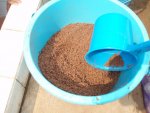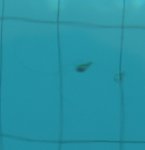Reindeerboy,
One thing I regret is that my sand filters seems to be average size.
If i knew any better I would have bigger ones. Well, I never care back then what the PB put in and sadly never knew Trouble Free Pool Academny..

until after a year I had the pool.
Anyhow I use Zelbrite which is zeolite. There are so many kinds of zeolites that do different things...by the 100s, including man made ones. As far as I did my homework, my type of zeolite is natural and the type that does the ammonia exchange. This is what a pool need, because its like having ammonia remover. If my understanding of the science is correct, for every ammonia caught by the zelbrite, salt/sodium is given out, hence the name ion-exchange. So regeneration is required to dump that ammonia by soaking with 10% salt mix for 24 hours and tripple backwash/rinse. The same drill if one house with well water uses water softener that uses ion exchange resin. So the calcium get exchanged with salt, sort of. I am no expert but that's what the technical literature from the manufacturer of the resin wrote.
Quality of natural zeolite varies from place to place, same like coal. I don't know if my Aussie mined zeolite is any better or worse than say from a US mined source.
Since my zelbrite/zeolite is like a sponge it is said to have 3 micron filtration capability, unlike sand which is not porous. However since the way zeolite and sand is stack up like that, we do get the typical method how sand does its filtration.
So in the end the actual filter retaining efficiency using zelbrite is still 80%, meaning only 80% of whatever rated size dirt will be caught but 20% will go thru in a single pass. A sand is said to have no better than 50 microns filtration, what its retaining efficiency %, I don't know but I suppose its not very far from 80% too since sand are stacked like zeolite.
If the waterflow is slower or the sand filter is huge, I am sure its going to be good for the user, the same advantage should apply to zeolite.
I wash the zelbrite properly before I use them in the sand filter. During processing they do contain lots of fine dust within the packaging.
Now if you ask me is Zelbrite ( or Zeobrite if spec is the same ) worth the money ?
I would say yes...a 100% yes, as long as you know how to maintain it and don't expect magic out of it. The ammonia removal and the 3 micron capability even at only 80% retaining efficiency is already worth the money. In my country it cost US$ 1.6 or so per 2.2 pounds before discount, bigger amount less $$ for sure. By how much I don't know. I imported my Zelbrite direct from Australia thru a local pool shop before anyone represent that brand in my country. Cost me much more than that, like 70% more money because the pool store that I asked to import, I gave him 25% profit for his work and it was only a small order, so I guess no bulk discount.
Why I don't like sand or the way the zeolite are stacked up in a sand filter housing is that 20% that will pass thru. However, we pool owners will have trouble if our filtration retaining efficiency is at 99.9% , since clogging will occur fast. Since a pool runs on principle of multiple pass over a period of time, we got what we need. In a car fuel system scenario with diesel common rail high pressure injection, its a single pass filtration requirement that matters because that is what the fine injector tip must receive...super clean fuel.
And then there is absolute rating and nominal ratings for filters for a given waterflow. This makes a big difference. I believe the pool industry will stick to nominal ratings, since its not that stringent and easier plus cheaper to make. Until today I can't get any literature on my cartidge filter retaining efficiency on the net. I posted the question but no one seems to know.
One thing I know, Hayward or Pentair, the OEM for the cartridge filter is the same. One thing I would want to remind cartridge filter user, it does not like Sun Block oil. A very reliable source told me that the cartridge filter material will get damaged by that oil. I don't know how but that's what he warned me.
The reason I use cartridge downstream fo my sand is because of that 20% that will pass thru from the sand/zeolite filter. Without a sand upstream, my cartridge will clog fast. Now without bather load and being an outdoor pool and in the center of the city, my cartdrige needs cleaning ( 5psi increase ) at least every 10-14 days. I stick to 5 psi because above that I loose waterflow to the extend I am not happy about it. The flowmeter showed that.
The other reason I use cartridge is that double filtration is better if final clarity is what I want to achieve. If I floc my pool, the worth of the cartridge is obvious, it does not allow the fine dirt to come back to the pool. This I can't do with sand/zelbrite alone. If you think you can't see a 50 micron dirt, try to collect enough of it and dump that in your pool, tell me if you can see that or not...you will see it. Calcium clouding is a good example, its so small your filters can't really "catch" it but you can see it right ...to the extend of ******* us off.
I don't want a DE because they don't sell the DE powder here...ha ha ha, what a joke. I will be enslaved by that requirement. Closest import will be Singapore and I bet the custom will strip search me for bringing what they think could be "Colombian Powder"...

everytime I fly in from Singapore.
Water clarity is a personal thing. If your pool is colored and you do not wear a mask while swimming, I mean a real good glass mask not a plastic Speedo goggles, your demand on clarity may not be the same as what I term as maximum clarity that I am trying to achieve in my pool.
One can say they can see the bottom of their pool of 6 feet deep and they are happy. If I can't see a strand of hair on my white tiled pool at 13 feet deep, I know something is already wrong. A hair test is what I like best. Always one or two strand of hair will fall off from divers in the pool.
Cheers









 ) that you should use pea gravel that was for swimming pool filters. I went to two pool places and asked. The looks on their faces was enough to make me laugh. One pool place gave me "No" followed by a you should never put pea gravel in a filter; "It will wreak your filter".
) that you should use pea gravel that was for swimming pool filters. I went to two pool places and asked. The looks on their faces was enough to make me laugh. One pool place gave me "No" followed by a you should never put pea gravel in a filter; "It will wreak your filter".